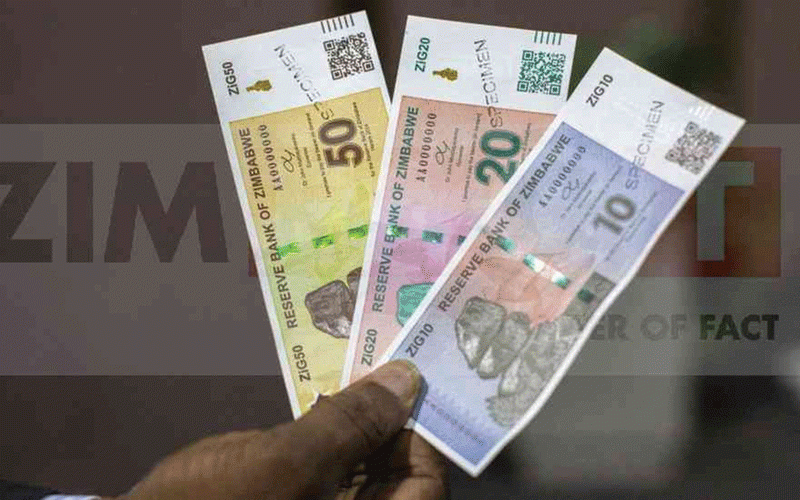
The primary role of banks is financial intermediation. However, in recent years, local banks have increasingly shifted toward generating income from non-funded sources, particularly fees and commissions, rather than traditional interest income. This shift has largely been driven by ongoing currency issues.
Loans and advances within the sector have become heavily skewed towards United States dollars, as most banks have sought to limit their exposure to the local currency. This strategy aims to hedge against the risk of asset-liability mismatches, where inflation and exchange rate premiums erode the value of repayments, leaving lenders with returns below what was originally anticipated.
With the introduction of the Zimbabwe Gold (ZiG) currency in April 2024, the Reserve Bank of Zimbabwe (RBZ) aimed to gradually grow its share in the economy, eventually gravitating towards a mono-currency system.
As ZiG reached its one year milestone this month, it is timely to assess how banks have responded to its introduction. The key question now is whether there is a likelihood of banks expanding exposure to ZiG in the short to medium term, especially considering the central bank’s recent monetary policy statement, which reaffirmed its goal of increasing ZiG’s market presence and highlighted a relatively stable exchange rate premium, attributed to its hawkish policy stance.
As illustrated in the accompanying graph, over 85% of loan disbursements were made in foreign currency. While there was a slight uptick in local currency exposure in August, it quickly reversed in September — likely due to the currency devaluation that occurred during that month.
Individuals accounted for the largest share of loan disbursements at approximately 28%, followed by the agricultural and manufacturing sectors, which received 16% and 15% respectively. A similar trend is observed in deposit composition, with US dollars making up roughly 87% of total deposits as of the end of January 2025. However, the sectoral distribution differs: the services sector leads with around 34% of total deposits, while individuals contribute only about 12%.
Recently, some banks with surplus ZiG were criticised for not supporting those facing deficits, prompting regulatory measures aimed at encouraging greater use of ZiG. While these steps may help in the short term, the question remains whether they are sufficient to significantly boost ZiG adoption within the banking sector.
From my perspective, the likelihood of a substantial shift toward increased ZiG usage in the near future remains low. Why?
- RBZ blocks Harare US dollar charges
- Industry cries foul over new export surrender requirements
- One stitch in time saves nine
- Banks keep NPLs in safe territory
Keep Reading
Given that individuals account for the largest share of loan disbursements — and considering that over 80% of transactions in the economy are still conducted in foreign currency — it is reasonable to question why individuals would opt for local currency loans over US dollars, unless driven by speculative motives which have not been happening due to scarcity.
While the central bank has implemented tight liquidity controls, ZiG has yet to gain significant traction. As market participants, many of us are waiting to see how authorities plan to meaningfully incentivise and expand the currency’s market share, because relying on scarcity is merely a short term fix.
Looking at the manufacturing sector, the 2024 survey by the Confederation of Zimbabwe Industries highlighted high production costs as the primary challenge, contributing to a decline in capacity utilisation to 52,3% by the end of December 2024, along with a drop in overall output.
This underscores a broader issue. Raw materials are priced in US dollars, and the resulting cost pressures are largely due to currency mismatches. Despite the sector being the third beneficiary of loan disbursements, throughout 2024, manufacturers increasingly turned to the informal market to raise foreign currency, by-passing formal retail channels due to the difficulty in converting ZiG through official means.
According to the same survey, 83% of firms in the manufacturing sector depend on domestic sales for their foreign currency needs, with limited interest in exports — mainly to avoid the 30% retention requirement imposed by the RBZ. This further confirms that US dollar cash remains the preferred medium in the real economy.
The recent move under Statutory Instrument 34 of 2025 to liberalise the exchange rate is a step in the right direction.
However, what market players now need is the assurance that US dollars can be reliably generated and accessed through formal channels, especially considering that US dollar reserves have grown to approximately US$629 million as of March 2025, while ZiG in circulation remains well below that level.
Take CBZ and NMB, for example, these banks actively raised US dollars throughout 2024 to support key productive sectors of the economy. Most recently, CABS renewed a US$40 million facility with Afreximbank and expanded its line with the Trade and Development Bank to US$50 million.
What this clearly signals is that phasing out the US dollar from the banking sector in the near future remains highly unlikely. All signs point to the US dollar continuing to serve as the de facto anchor currency, underpinning much of the financial system’s functionality.
- Taimo is an investment analyst with a talent for writing about equities and addressing topical issues in local capital markets. He is an active member of the Investment Professionals of Zimbabwe community, pursuing the Chartered Financial Analyst charter designation.











